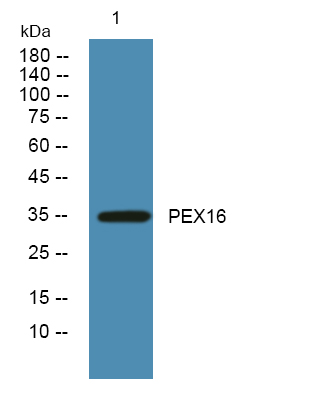
| WB | 咨询技术 | Human,Mouse,Rat |
| IF | 咨询技术 | Human,Mouse,Rat |
| IHC | 咨询技术 | Human,Mouse,Rat |
| ICC | 技术咨询 | Human,Mouse,Rat |
| FCM | 咨询技术 | Human,Mouse,Rat |
| Elisa | 1/10000 | Human,Mouse,Rat |
| Aliases | Peroxisomal membrane protein PEX16; Peroxin-16 |
| Entrez GeneID | 9409 |
| WB Predicted band size | Calculated MW: 39 kDa; Observed MW: 36 kDa |
| Host/Isotype | Rabbit IgG |
| Antibody Type | Primary antibody |
| Storage | Store at 4°C short term. Aliquot and store at -20°C long term. Avoid freeze/thaw cycles. |
| Species Reactivity | Human,Mouse |
| Immunogen | Synthesized peptide derived from human protein . at AA range: 100-180 |
| Formulation | Purified antibody in PBS with 0.05% sodium azide,0.5%BSA and 50% glycerol. |
+ +
以下是关于PEX16抗体的3篇参考文献及其摘要内容概要:
1. **《PEX16 contributes to peroxisome biosynthesis by functioning as a membrane anchor for PEX3》**
- **作者**:Hettema et al.
- **摘要**:研究揭示了PEX16在过氧化物酶体生物发生中的关键作用,利用特异性抗体证实其作为PEX3的膜锚定位点,促进过氧化物酶体膜的组装和功能完整性。
2. **《Mutations in PEX16 are associated with severe Zellweger spectrum disorders》**
- **作者**:Ebberink et al.
- **摘要**:通过免疫印迹和免疫荧光实验(使用PEX16抗体),发现患者细胞中PEX16突变导致过氧化物酶体完全缺失,阐明了该基因缺陷与致命性过氧化物酶体疾病的关联。
3. **《PEX16 interacts with PEX19 and mediates the peroxisomal membrane protein targeting》**
- **作者**:Matsuzaki et al.
- **摘要**:研究利用PEX16抗体验证其在哺乳动物细胞中的定位,证明PEX16通过与PEX19结合介导膜蛋白靶向,对过氧化物酶体形成至关重要。
**Background of PEX16 Antibody**
PEX16. a peroxisomal membrane protein encoded by the *PEX16* gene, plays a critical role in peroxisome biogenesis. As a member of the peroxin (PEX) family, it is essential for the formation of peroxisome membranes and the recruitment of cytoplasmic proteins to these organelles. PEX16 is involved in the early stages of peroxisome assembly, facilitating membrane elongation and the import of matrix proteins. Mutations in *PEX16* are linked to severe peroxisome biogenesis disorders (PBDs), such as Zellweger spectrum disorders (ZSDs), characterized by neurological dysfunction, liver abnormalities, and developmental delays.
PEX16 antibodies are vital tools for studying peroxisome dynamics, protein localization, and disease mechanisms. These antibodies enable the detection of PEX16 in various experimental models (e.g., Western blot, immunofluorescence) to assess its expression, subcellular distribution, and interactions. Research using PEX16 antibodies has advanced understanding of peroxisome-related pathologies and potential therapeutic strategies, particularly for inherited metabolic disorders. Commercial PEX16 antibodies are typically validated for specificity and sensitivity, ensuring reliability in both diagnostic and research contexts. Their application continues to support investigations into cellular lipid metabolism, organelle biogenesis, and the molecular basis of PBDs.
×